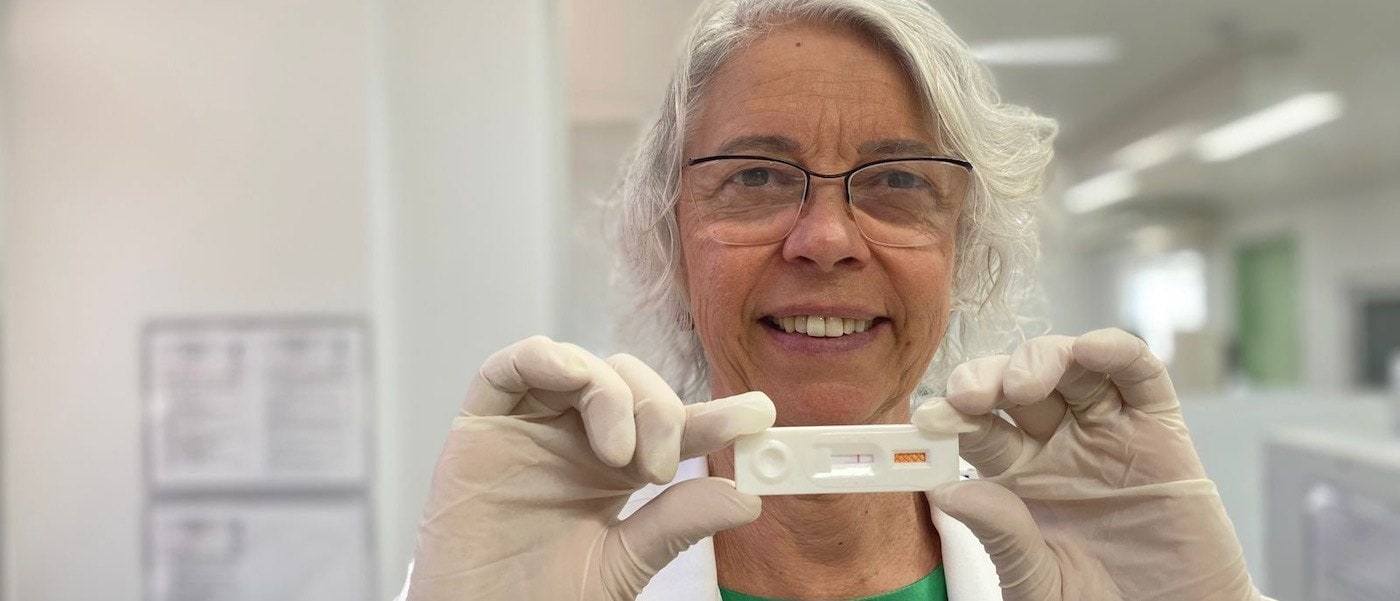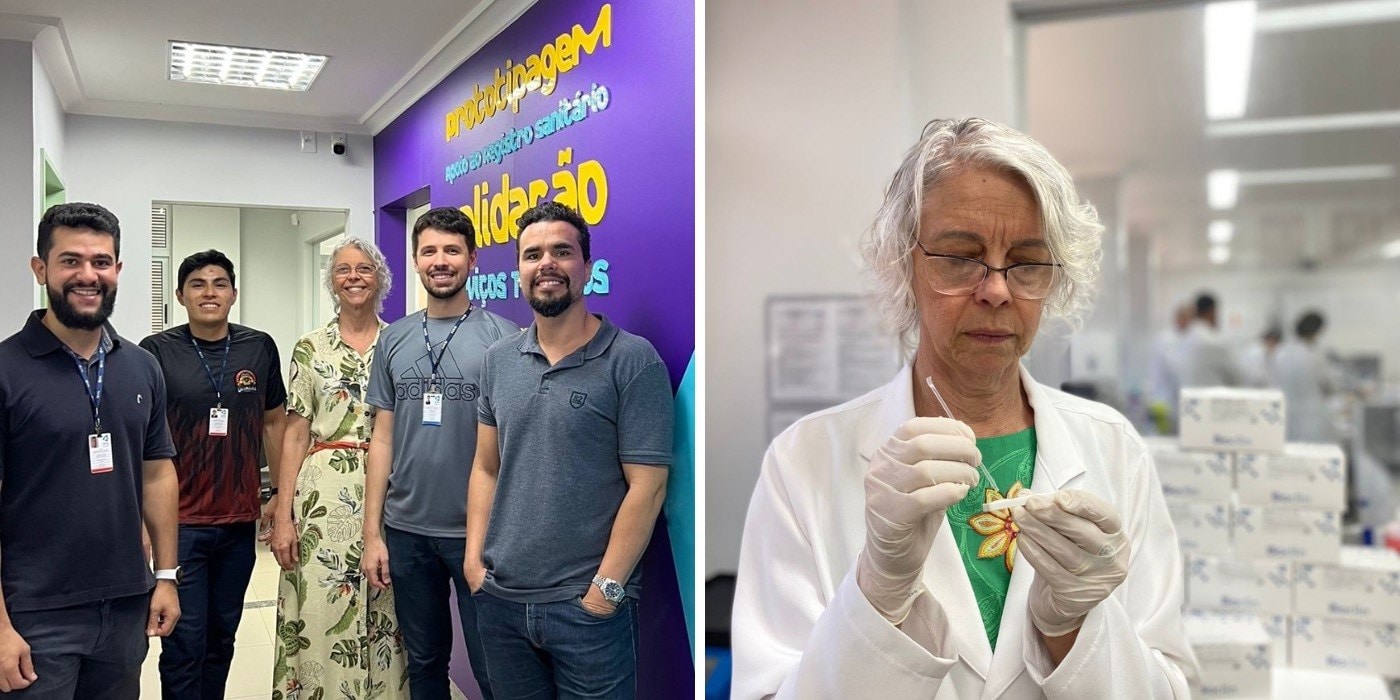New Tests for an Old Disease
Motivated by someone close to her, Dr. Samira Bührer designed and brought leprosy rapid tests into communities across Brazil with the support of Merck.

Image courtesy of the Institute of Tropical Medicine and Public Health of Federal University of Goiás State.
February 20, 2023 | 5 min
After working relentlessly for nearly 20 years, they finally arrived. On the outside, it looked like any other box appearing in a departmental mail room. But inside was something nobody, not even lab members, had seen: ready-to-use leprosy rapid tests.
Before April 2022, testing for leprosy — now referred to as Hansen’s disease — in Brazil was confined to some specialized clinics. It was difficult to get tested, diagnosed and treated — especially in remote areas, where hotspots of Hansen’s disease are found.
For Dr. Samira Bührer, a senior researcher at the Federal University of Goiás in Brazil, it was hard to comprehend the weight of the accomplishment. “It’s something that I did for others, but I ended up getting so much fulfillment,” she reflects.
The idea originated from her doctoral supervisor, Dr. Paul Klatser, who first invited her to develop the test in the late '90s. In 2018, after decades of work to introduce the test, Bührer started feeling quite confident in her team’s new rapid test for Hansen’s disease, but she knew that taking an idea from the bench to market would take new collaborations. She was ready to find an industry partner, but hadn’t yet found the right fit.
Enter Misael Silva. As part of his role at Merck, he connects with academic customers across Latin America to learn more about their work and their pain points, ultimately helping academics take their research beyond the bench with the support of industry partners. Thinking back to the first meeting, Bührer smiles. It left her full of hope. Silva believed in her mission and was set on making the right connections to drive the project forward.
At that point, Bührer had already been on a long — and a bit unconventional — career path.
Not According to Plan
Knowing what Bührer’s accomplished, it’s remarkable that she started her career in science a bit later in life. In 1989, a dozen years after she completed her undergraduate studies, Bührer start thinking about going back to university to study applied immunology. In the decade prior, she stayed home to raise two boys, and was eager to gain new skills and return to the workforce.
In the same period in Brazil, someone close to her was struggling with worrisome symptoms, but despite consulting multiple physicians, the cause remained elusive. Only after the presence of irreversible deformities did a proper diagnosis emerge, despite seeking help from various specialists.
Finally, they had an answer: Hansen’s disease.
The chronic condition causes skin lesions, nerve damage and deformities, among other symptoms. The disease is ancient. It makes a prominent appearance within biblical stories, and today it continues to impact millions of people worldwide. India, Brazil and Indonesia make up about 75% of cases worldwide. In 2022, India reported more than 100,000 new cases, Brazil reported about 20,000 and Indonesia more than 12,000.1 Recently, the World Health Organization intensified its focus on the fight against Hansen’s disease. The Ministry of Health of Brazil also made reducing cases and improving treatments a priority for the country.
Unfortunately, the disease still holds a stigma, and many people are reluctant to seek help or care. While a 6- to 12-month course of drug therapies can cure patients, early treatment is important to prevent permanent disabilities and chronic pain. Regular testing is challenging, as for years the only option to test meant traveling to a specialized clinic.
Some refer to leprosy as a “forgotten” or “orphaned” disease due to its difficulty in receiving the proper diagnosis.
Bührer returned to university with a renewed purpose: to spare others from experiencing their struggles. Her thesis focused on the development, evaluation, and application of a test to enhance disease detection efficiency. "Upon completing my studies, the Netherlands Leprosy Relief distributed 400 copies of the content globally,” she says.
Partners with a Shared Purpose
Bührer returned to Brazil. Ultimately, she found an academic home as a researcher at the Federal University of Goiás. There she continued her work towards finding a better way to test for leprosy.
Misael Silva entered the scene at an opportune time. Bührer was in the midst of trying to commercialize the test and had more questions than answers. It can be difficult to find the right contacts, materials and resources to make that transition, especially in the midst of the COVID-19 pandemic.
“I served as a translator, helping Dr. Bührer talk about her work in an industry setting, rather than strictly academia,” says Silva. Silva helped identify the Merck materials she needed to build out the tests and connect Bührer with strategic partners to bring the test from the lab to market.

(L) The Merck team meets with Dr. Bührer and researchers. Clockwise left to right: Matheus Fogaça -PhD, Djairo Pastor, PhD candidate, Dr. Samira Bührer, lab lead, Leonardo Luz, PhD, and Misael Silva. (R) Dr. Bührer demonstrates how the rapid test is used. Image courtesy of the Institute of Tropical Medicine and Public Health of Federal University of Goiás State.
In September 2021, Merck signed a strategic alliance with the Federal University of Goiás to create the Innovation Hub in Point of Care Technologies, aimed at prototyping rapid diagnostic tests to help them reach the market faster. This includes rapid tests for Hansen’s disease and others. By reducing the delay between the concept and market debut, the partnership aims to help more patients in less time.
The partnership with Merck opened new doors for Bührer’s research. “If Merck is supporting you, then others believe in you.” A year and a half passed between when Silva and Bührer first met to when the boxes with the tests arrived in her lab. Considering global shortages on raw materials due to the high demand of COVID-19 tests, that timeline is remarkable.
The kits are now in circulation across Brazil. Silva is proud of the connections he helped make for Bührer, which alongside raw materials from Merck, helped bring the tests from academia to the public. Efforts are underway to introduce the kits to India, another nation impacted by Hansen’s disease.
For Bührer, it's hard not to think about how her research might impact the lives of people suffering from such a neglected disease. "It really makes me happy.”
Her work isn't ending with this success. Her group is collaborating to create better diagnostics for a wide variety of diseases, including Listeria and, of course, Hansen’s disease. Merck is eager to support her next pursuits.
Citation
Supporting In-Vitro Diagnostics (IVD)
Developing tests require a handful of raw materials that are critical to ensure their accuracy and success. Estapor®, Hi-Flow™, Probumin®, Proclin™ and Surewick® play an essential role in the work of IVD manufacturers worldwide. These materials ensure manufacturing continuity, lot-to-lot consistency, regulatory compliance and clinical test reliability. Review the specifications.
To continue reading please sign in or create an account.
Don't Have An Account?